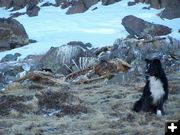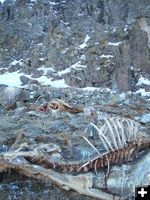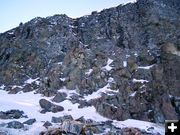

Elk photo 3
The carcasses were discovered near
Carter Mountain.
|


Elk photo 4
A wolf was seen in the area while the
carcasses were being investigated.
|


Elk photo 5
This is the scene horn hunters stumbled upon.
|
|
Thirty-six elk plunge to death
Over 150-200 foot rock face on Carter Mountain west of Meeteetse, Wyoming
by Courtesy Echo Renner
April 28, 2009
Thirty-six head of elk plunged to their death over a 150 Ė 200 foot rim rock on Carter Mountain west of Meeteetse in January. Horn hunters discovered the carcasses last month, and reported it to area landowners, Scott and Marjorie Justice.
"We set up a spotting scope and could see ravens and birds in the area. We called the game warden, and went up with him," explains Scott Justice.
Jim Olson, Meeteetse area Game Warden with the Wyoming Game & Fish Department (WGF) says they discovered the elk carcasses at the base of the rock face. One cow elk got stuck on the way down, and remains there.
"There were seven yearling males, 12 adult females, 10 calves, and seven unknown that slid down over another cliff," says Olson. "The cliff is near where the elk normally travel through a chute in the rim rock. The calf ratio was high and I believe young animals were leading charge, and thatís why they missed. Something spooked them and they went over. It could have been wolves, helicopters, a storm - who knows." He adds, "I have not seen this before in my career."
Scott Justice describes, "The chute is right next to that cliff. It looked like some of the elk were still alive (after the fall) with broken legs, and wallowed around and died." He continues, "Weíve seen up to 1,000 head of elk waiting there, and take over an hour to come single file down the chute during the evening to feed. Someone told me that was on old hand-dug stock trail where they used to trail domestic sheep off the mesa years ago. Itís broken now and real steep. It would be hard to get a horse down. My guess is those elk were all crowded around there, and wolves or something, spooked them over the cliff. Itís odd there were seven young spikes with the cows and calves, because the spikes usually hang out by themselves." Justice adds, "When we were there with Jim Olson, a white-grey wolf came down the chute. A week later, we saw a big black wolf and a white-grey wolf playing in the snow, about 300 yards to the right of the jump."
Chancey and Karla Gitlitz of the 91 Ranch say the area is a checkerboard of property managed by the BLM and property owned by the 91 Ranch, but the elk probably landed on BLM. Though grizzly bears, wolves, and other scavengers have since fed on the carcasses, Gitlitz says she doesnít believe a grizzly frightened the elk over the cliff, as the bears were still in hibernation in January. Grizzlies and wolves have attacked 25 head of 91 Ranch cattle in recent years, including a wolf attack on a bred cow last month.
Ed Bangs, Wolf Recovery Coordinator with the US Fish & Wildlife Service (FWS) in Helena says, "This kind of thing happens, and is more common than you think. It can be impossible to determined what happened if it had been awhile. It sure could have been wolves or other native predators that spooked a herd, but depending on how long ago it happened, my first line of investigation this time of year would be an avalanche. Wild animals die from accidents all the time. The most interesting thing is people would think wolves are somehow more responsible for these types of things than anything else - seeing the world through wolf-colored glasses I suppose. But, absolutely it could have been wolves. Wolves are huge scavengers, so almost any thing that dies for any reason, wolves will try to get a "free" meal. That is partly a factor on why they have such a huge reputation as livestock killers in the old days. Not only did they kill stuff, they fed on carcasses they came across, leaving plenty of wolf sign." He adds, "However, these types of "natural" accidents are unusual enough that they almost never make any difference in the overall dynamics of wildlife populations."
Dr. Charles Kay, Adjunct Professor at Utah State University, conducts unbiased research on wolves and other wildlife. Kay says, "Several years ago there was a large herd of antelope that ran over a cliff and were killed near Green River. I do not recall anything similar with elk, but it would not surprise me if wolves or a bear could spook a herd (in this manner)."
The event Kay describes took place in November 1991, when 150 pronghorn tumbled over a 100-foot precipice near Green River, within sight of the interstate. Tom Christiansen, now Sage Grouse Program Coordinator with the Wyoming Game & Fish Department (WGF) was then a Regional Biologist. He and Game Warden, Allen Round, investigated the scene and back-tracked the herd. "It was very foggy when this happened, and it isnít certain if they went completely of their own volition, of if they were spooked. We were never able to determine exactly what pressured them, if anything. They went off the cliff one after another," recalls Christiansen.
In March 1944, the WGF reported 100 antelope were found dead at the base of a 45-foot cliff in southern Campbell County. Officials theorized the antelope may have been blinded by a storm and went off the edge of the bluff, or that they were frightened and jumped from it.
On Alaskaís Afognak Island in the October 1986, approximately 45 elk plunged over a 300-foot sheer cliff, landed in a chute and tumbled or slid to the beach. Alaska Department of Fish & Game (ADFG) Wildlife Biologist, Larry VanDeele, examined the tangled mass of dead elk at the bottom of the cliff, and told the Roundup, "The best we can tell, it was hunter related." The report states the elk were seen on the cliff on about the day of the fall, there were numerous hunters in the area, some who put a "pincer" movement on the elk which culminated near the cliff when a barrage of two dozen or more shots were fired. The report concludes, "Without an actual eye-witness to the event, it cannot be positively stated that the accident did not occur earlier or in different circumstances than those described." VanDeele explains, "The only real predators on the island are humans. There are Kodiak brown bears there, but theyíre not actively aggressive like grizzly bears. There are no wolves or coyotes on the island."
Robert Wharff, wildlife biologist and Executive Director of Wyoming Sportsmen for Fish & Wildlife says, "A healthy animal is not going to simply walk off a cliff, whether itís in the middle of the night or the middle of the day. Native Americans historically chased bison over a cliff, and I wouldnít be surprised if the Indians learned by observation Ė perhaps they saw it happen and said, "We can do it." I donít know if wolves intentionally chased the elk off the cliff, but if they did and were successful, we might see more of that happening. Itís about survivability, and wolves kill to survive. Elk are smart and incredibly agile. I think itís highly unlikely and illogical that the elk just walked off the cliff on their own."
Native American Indians used steep cliffs as buffalo jumps by herding the bison and funneling them over the cliff. The buffalo jump is also known as a "pishkun" by the Blackfoot Tribe, which can be loosely translated as "deep blood kettle." Once at the bottom of the cliff, members of the tribe butchered the bison, cut strips of met for drying, and selected the best hides for skinning, to provide for their own survival.
Jim Allen of Lander, a long-time outfitter and President of the Wyoming Outfitters and Guides Association (WYOGA) says, "Elk are incredibly agile and athletic. Iíve seen them go over a cliff I didnít think a big horn sheep would go over. They had to be more afraid of what was chasing them than the cliff. I donít think a grizzly was after them. They could maneuver away from a single grizzly, and grizzlies donít travel in packs. It would be the same with a mountain lion. My opinion is wolves organized this effort, and did it very successfully."
In October 2006, wolf researcher, Jim Akenson, was riding a mule on an icy mountain trail in the Frank Church River of No Return Wilderness in central Idaho, when he came upon a dead cougar. Suddenly, a pack of wolves materialized and began howling. For a terrifying moment, the 48-year-old biologist thought his startled mules were going to stampede and carry him off a 200-foot cliff. "It is the most precarious condition you can image, with wolves howling around you."
At least a monthís time had passed before the elk carcasses were discovered on the slope of Carter Mountain, therefore the reason for this plunge of death will probably remain a mystery. Chancey and Karla Gitlitz are simply thankful this unfortunate incident didnít happen to their cattle.
Echo Renner is a Field Editor for the Wyoming Livestock Roundup, and can be reached at echo@wylr.net.
Photos by Scott & Marjorie Justice
|
